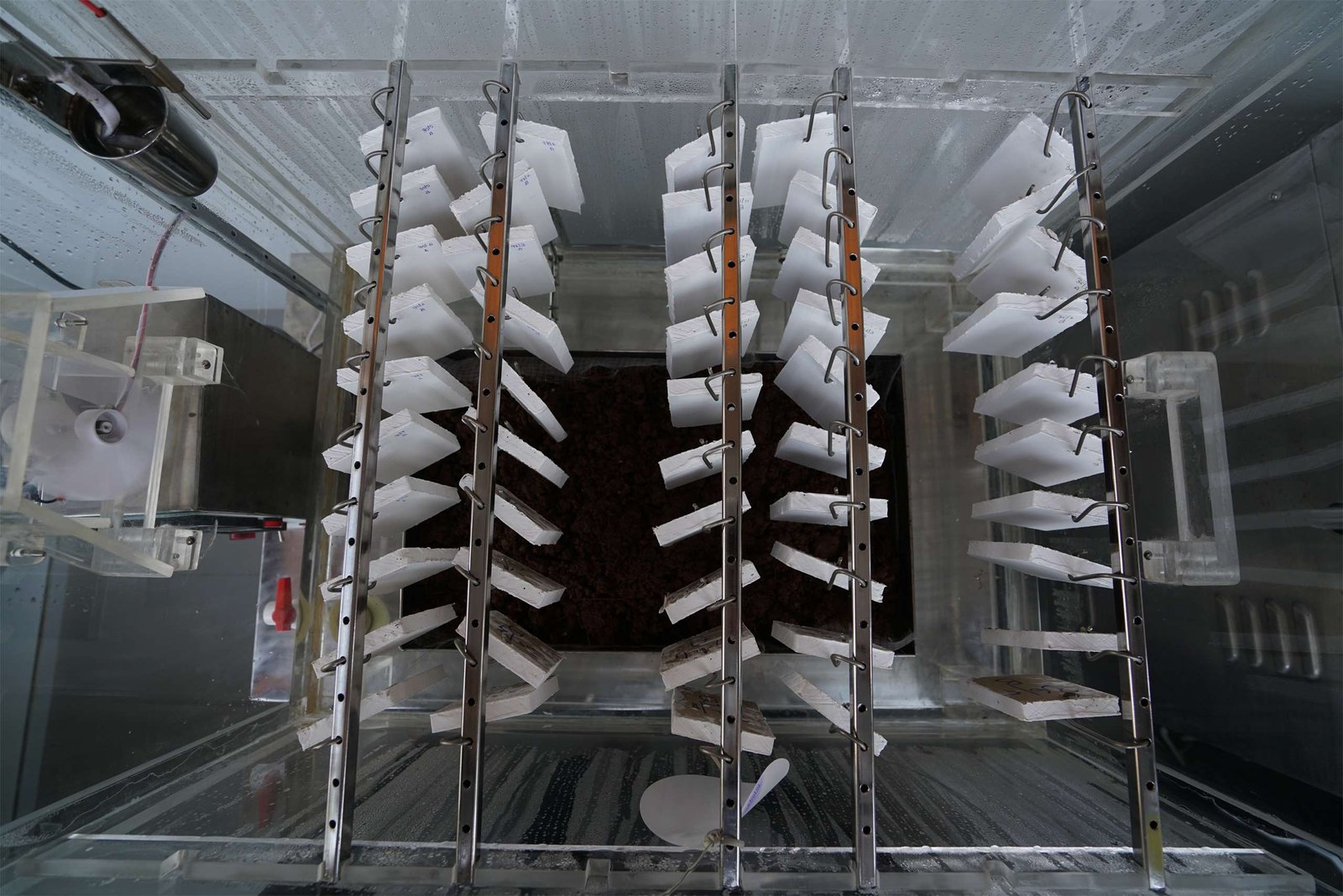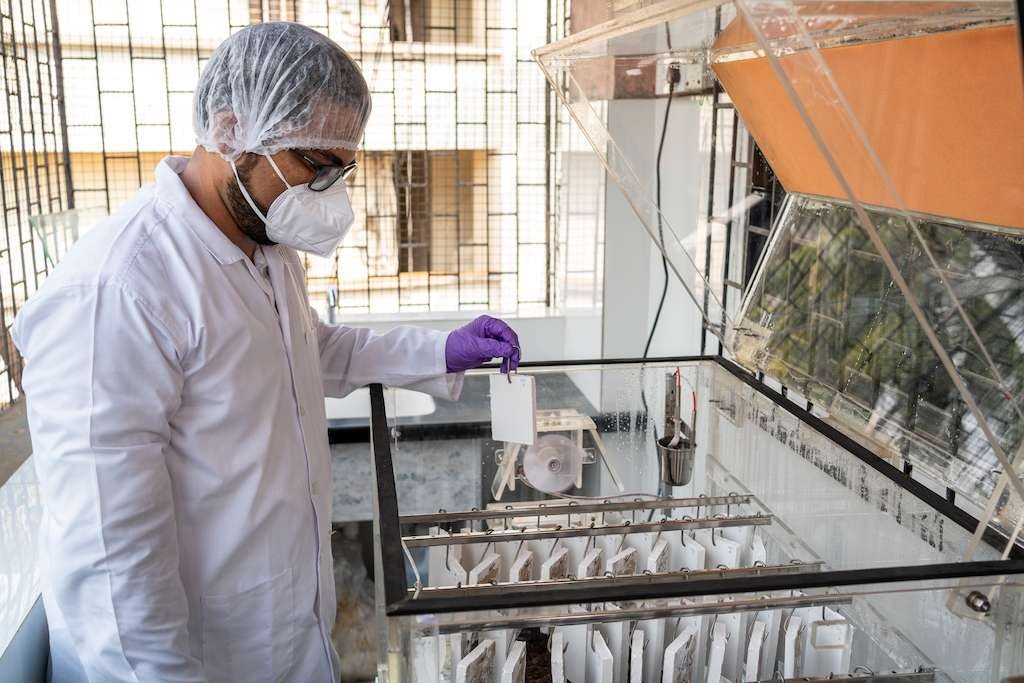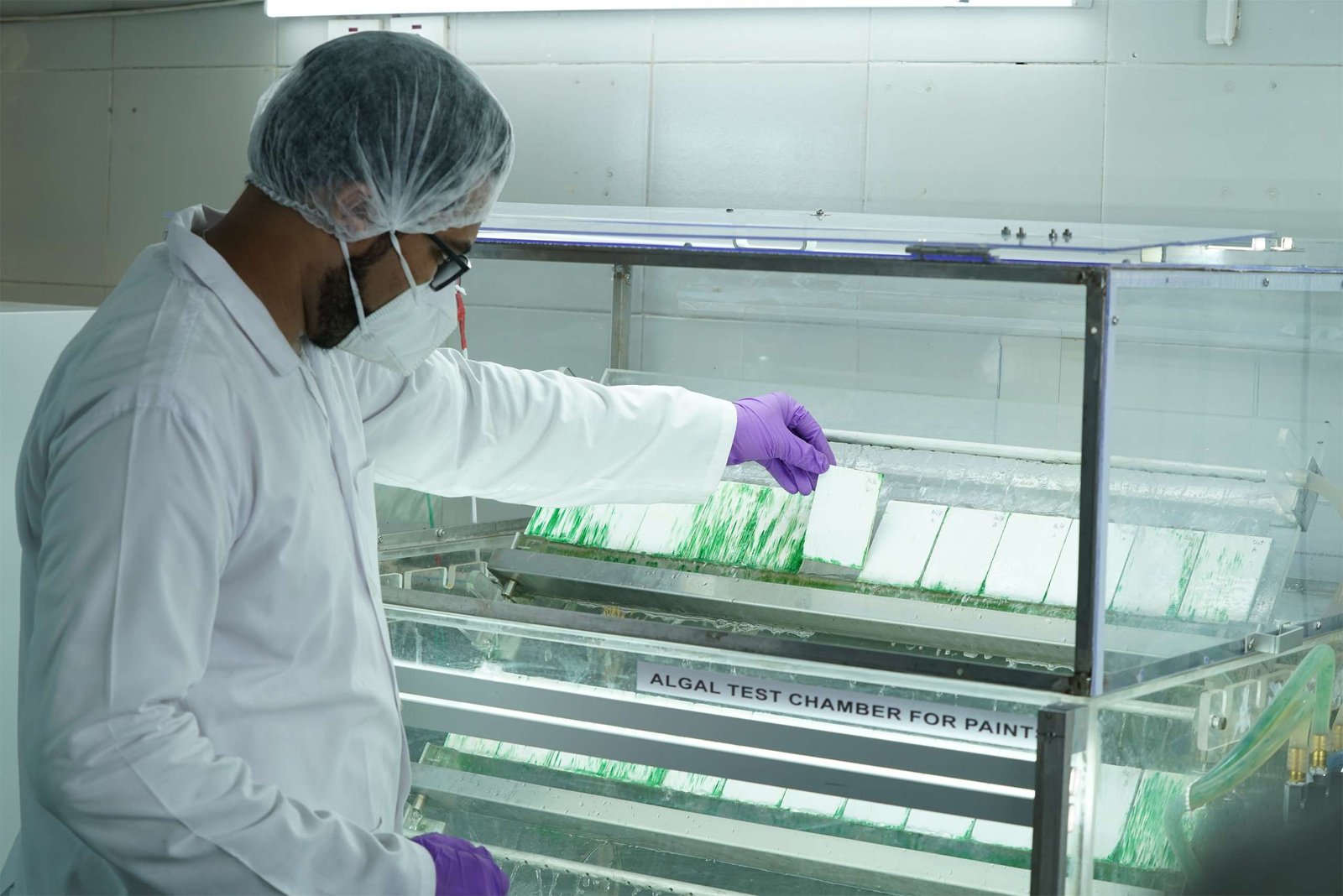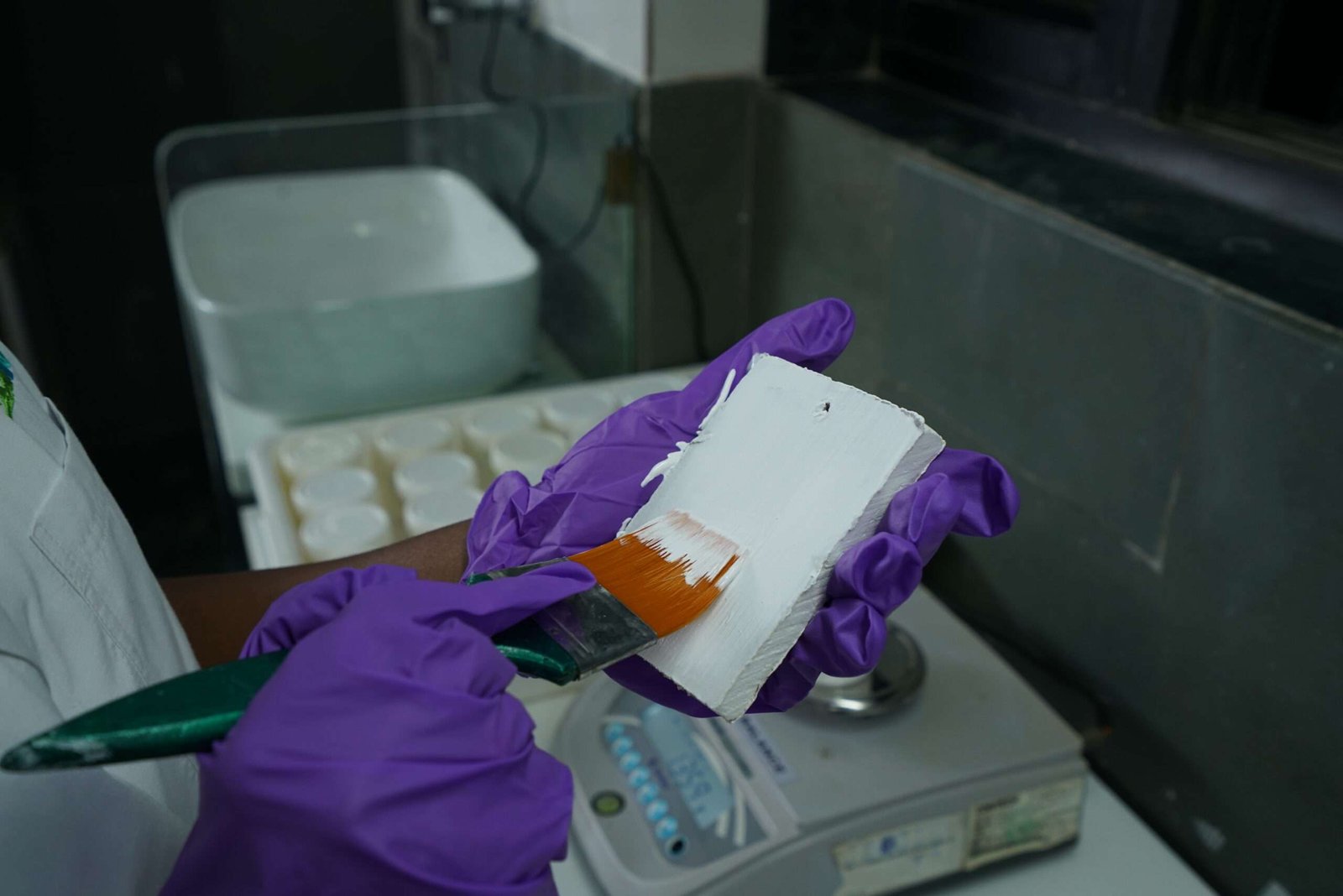Microbiological Testing Facility For Paint





Paint Testing
Biotech Testing Services (BTS) is a leading paint testing laboratory. We specialize in testing paints with antibacterial, anti-viral, and anti-fungal properties. Our wide range of paint testing methods guides industries in product development.
We evaluate antibacterial paints using ISO and JIS methods. Antiviral properties are assessed through ISO standards, using both enveloped and non-enveloped viruses. BTS conducts ASTM screening tests for antifungal and antialgal formulations of dry film paints.
Our coating test laboratory simulates real-life conditions to assess the antifungal resistance of painted surfaces. We also evaluate the antialgal property through a unique chamber method.
Routine QC analyses are carried out from raw materials to end products. This includes preservative challenge tests for paints and adhesives using bacteria, fungi, algae, as well as organisms from spoilt paint.
BTS also undertakes hygiene sampling of plant facilities. This helps identify sensitive areas with respect to microbial proliferation and control. Trust BTS for comprehensive antimicrobial paint testing and coating testing services.
Methods of Testing
Determination of Microbial conditions of paint, Paint Raw materials and Plant areas
Scope:
This method evaluates degree of contamination of raw materials wet or dry as well as Plant sites. Liquids, Powders or swab samples are received at laboratory. They are processed on media for bacterial and fungal growth by a semi-quantitative Streak plate method. The plates are evaluated based on no. of colonies and are rated 0 to 4.
Expression of Results: Sterility/ Contamination of Test material. Identification of Contaminants (Bacteria, Molds and Yeast) Rating of Degree of contamination.
Turnaround Time: 5-7 days
At Biotech Testing Services (BTS), we offer a comprehensive method for determining the resistance of emulsion paints to microbial attack. Initially, this test is designed to challenge paint samples with a known amount of bacteria. Subsequently, it rates the paint’s ability to control the organism. This process assists manufacturers in selecting an effective preservative and evaluating its performance.
We carry out antimicrobial paint testing method - ASTM D2574, which exposes products to mixed fungal and bacterial cultures in a controlled setting over two weeks. It challenges paint samples containing various levels of biocides with a known amount of bacteria. Consequently, the results can guide manufacturers in selecting the most effective preservative and evaluating the performance of their emulsion paint additive.
The effectiveness of preservation is determined based on the absence or presence of bacterial and fungal count from preserved samples with repeat challenges over a period of four weeks or longer. Interestingly, the method is semi-quantitative and relies on a rating scale.
In addition to this, BTS also focuses on the environmental impact of materials like paint in their liquid form. We evaluate a paint’s biodegradability or toxicological effects on the environment and living organisms. This is an important quality that can increase market value and distinguish the product from other paints.
Trust BTS for comprehensive antimicrobial paint testing and coating testing services. Our turnaround time is 28 days.
The ASTM D 4783 Standard Test Method actively determine the resistance of adhesive preparations, including paints and coatings, to attacks by bacteria, yeast, and fungi. By challenging adhesive samples with known amounts of these organisms, the tests provide a robust measure of the effectiveness of biocides used in these preparations.
These methods are particularly beneficial when tested against wild-type microorganisms isolated from contaminated adhesives. This aids manufacturers in determining the necessary amount and type of biocide to inhibit the growth of contaminants. Consequently, it helps improve the quality and longevity of paints and coatings by ensuring they are adequately protected against microbial attack during their storage life.
The procedure for conducting ASTM D 4783 involves challenging adhesive specimens with cultures of bacteria, yeast, or fungi, and checking for their ability to return to sterility. The test involves a serial dilution method of determining plate count using a pour plate technique2. To neutralize the effect of active biocide carried over from the adhesive specimen to the agar, which could inhibit the growth of microorganisms, the use of Letheen agar and broth is recommended.
The test results are based on the absence or presence of bacterial and fungal count from preserved samples over a period of 4 weeks or longer. This provides a semi-quantitative measure of the effectiveness of preservation based on a rating scale.
ASTM D5590 – Fungal Resistance of Paint (Dry film test) is a standard antimicrobial testing method. It quickly determines the resistance of paint films and related coatings to fungal defacement. This is achieved through an accelerated four-week agar plate assay. It’s widely used to compare and evaluate different coating formulations. This helps in determining their relative performance against fungi under specific conditions.
This method provides a fast way to assess the relative resistance of paints or coating films to fungal growth. It serves as a screening test and is not intended to replace the Fungal chamber exposure method.
The process involves spraying a mixed fungal inoculum onto the substrate. This inoculum consists of spores from Aspergillus niger ATCC 9642, Penicillium funicolosum ATCC 11797, Aurobasidium pullulans ATCC 15233
Test specimens are then evaluated based on a fungal growth rating scale from 0 – 4. This rating depends on the observed growth on the specimen.
You can expect a turnaround time of just 4 weeks.
This method is for determining the relative resistance of paint or coating film to algal growth. It is generally known that the difference in the environment, lighting, temperature, substrate and other factors in addition to the coating composition affect the susceptibility of a painted surface.
Defacement of paint & coating films by algal growth is a common phenomenon. This test method attempts to provide a means to comparatively evaluate different coating formulations for their relative performance under defined conditions.
Mixed algal incoculum comprising of Unicellular green algae, Filamentous green algae, colony forming green algae & Filamentous blue green algae are used.
Expression of Results:Test specimen are evaluated based on rating scale 0 – 4 based on observed growth on the specimen
Turnaround Time: 4 weeks
Standard Test Method for Paints: Assessment of Resistance to Fungal growth
Scope:
This method is used for assessing the fungal resistance of paints, varnishes & lacquers as part of Coating system. It evaluates Resistance of Interior coating to accelerated mildew growth. The test makes use of an Environment chamber.
Environmental Chamber maintaining a relative humidity of 95 % at a temperature of 32°C while providing a continuous inoculation of the surface of exposed panels with mold spores makes an accelerated test for determining the resistance of interior coatings to mold growth. It helps in estimating the performance of coatings for use in the interior environments that promote mold growth.
Expression of Results: Based on Visual Rating: Painted surfaces are observed for mold growth each week for 4 weeks on a 0 to 5 rating scale by estimating the percentage of surface defacement with 0 being no defacement and 5 being >70% defaced.
Turnaround Time: 4 weeks
Standard Antimicrobial Testing Method for Resistance to mold on the surface of interior coatings in an environmental chamber
Scope:
This method is used to evaluate comparative Resistance of Interior coating to accelerated mildew growth. The test makes use of an Environment chamber.
Environmental Chamber maintaining a relative humidity of 95 % at a temperature of 32°C while providing a continuous inoculation of the surface of exposed panels with mold spores makes an accelerated test for determining the resistance of interior coatings to mold growth. It helps in estimating the performance of coatings for use in the interior environments that promote mold growth.
Expression of Results: Based on Visual Rating: Painted surfaces are observed for mold growth each week for 4 weeks on a 0 to 10 rating scale by estimating the percentage of surface defacement with 10 being no defacement and 0 being completely defaced. It includes both test and non-test fungal growth in the rating.
Turnaround Time: 4 weeks
Scope:
This method is used for determining the susceptibility of paint films to microbiological attack on exterior exposure. It is considered as a practical and reliable method for determining the degree of discoloration that may occur on exposed coating due to microorganisms. The growth of fungi and algae in and on the surface of paint films represents a major cause of discoloration or disfigurement of painted surface.
This method involves preparation of coatings for testing. The paint is applied on substrates and then arranged on the exterior test fences to determine the degree of microbiological attack that may occur on the surface of the coating over a period of time. This practice provides claim guideline on resistance/ or susceptibility to discoloration/ disfigurement of exterior coating by algae and fungi.
There are critical factors which influence the amount of fungal growth on the same coated object when exposed to other conditions. These factors include Geographic location, local atmospheric conditions of dust and pollen, content of the air, angle of exposure, degree to which the coating is subjected & weathering, effect of moisture and sunlight, the substrate on which the coating is applied and last but not the least, the coatings in the paint system under test. The other factors include the stability of coatings, composition, thickness and composition of the undercoats that determine resistance/susceptibility to discoloration by microorganisms.
Expression of Results: Based on Visual Rating: Effective/ Not Effective
Turnaround Time: 2 years
Test for Antibacterial activity and Efficacy to bacteria on the surface of antibacterial products such as Paint film
This method evaluates antibacterial activity and efficacy of surface treated antibacterial products. Antibacterial value is the difference of log of viable bacteria between the Antibacterial treated product and untreated products after inoculation followed by incubation of bacteria.
Antibacterial effectiveness is when the log reduction is 2.0 or more.
Expression of Results: Effectiveness of Antibacterial finish based on Log Reduction of Bacteria in Treated substrate in comparison with Untreated Substrate
Turnaround Time: 7 days
Antibacterial treated Paints and other non porous surfaces of products including Intermediate products.
This method specifies evaluation of antibacterial activity of treated paints and other non-porous surfaces of products as well as intermediate products.
The value of the antibacterial activity can be used to characterize the effectiveness of antibacterial treatment.
Expression of Results: Effectiveness of Antibacterial treatment based on Log Reduction of Bacteria in Treated specimen in comparison with Untreated specimen/ Control.
Turnaround Time: 5-7 days
Evaluates anti-algal performance of exterior finishes and biocides
Scope:
All exterior finishes and biocides, which are known to offer resistance to algal growth, can be assessed by this method.
The method involves application of Paint on Panels as per Protocol used in Paint Industry. It is subjected to leaching process for short duration. These painted panels are exposed in Algae test chamber having continuous sprinkling of mixture of algae on Panels in three rows with adequate Controls. The process continues for 4 weeks.
Expression of Results: Based on Visual Rating: Painted surfaces are observed for coverage of Algal growth 4 weeks. Based on percentage of area covered by algal growth, panels are rated on a 0 to 10 rating scale by estimating the percentage of surface defacement with 10 being no defacement and 0 being completely defaced.
Turnaround Time: 4 weeks
This test method is used to determine the effects of a substance on the growth of fresh water microalgae and or cyanobacteria.
Exponentially growing algae is exposed to the test substance at various concentrations in batch cultures over a period of 72hrs. The algal response is evaluated as a function of exposure concentration in comparison with the average growth of replicate, unexposed control cultures.
In view of prohibition of Fish toxicity for LC50 / EC50, the IC50 for algae is suggested to be used to estimate aquatic toxicity.For textile auxiliariesIC50 values > 100mg/L is permissible wrt<70% biodegradability.
Expression of Results: Algal growth or inhibition measurement by Counting algal cells by Microscopic method or algal growth measurement by Absorbance
Turnaround Time: 7 days
